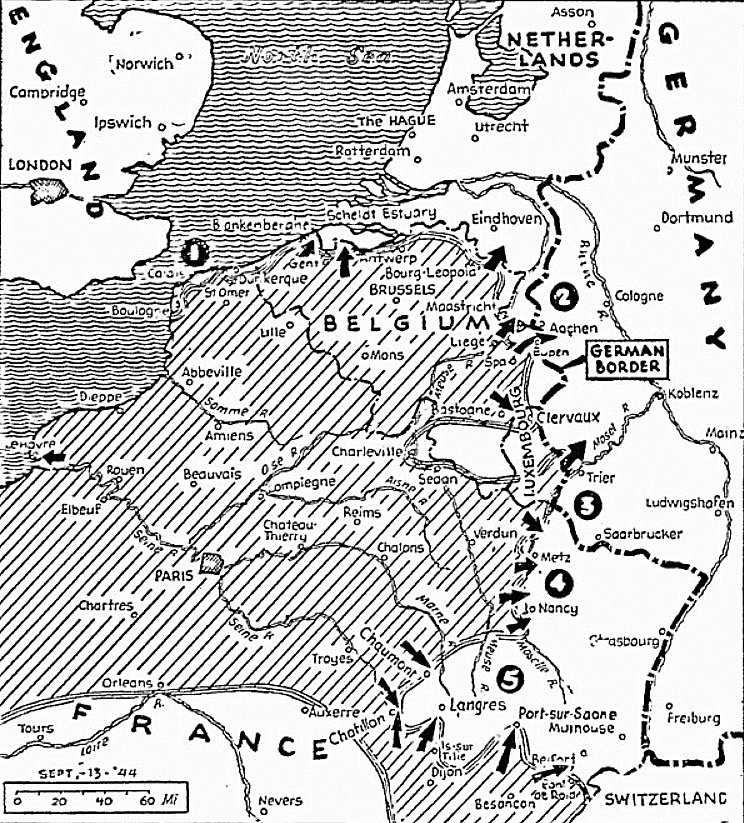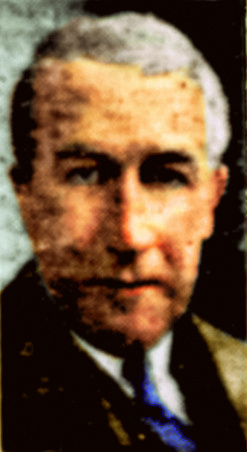Meeting of the Combined Chiefs of Staff, 2:30 p.m.
| Present | ||
|---|---|---|
| United States | United Kingdom | |
| Admiral Leahy | Field Marshal Brooke | |
| General Marshall | Marshal of the Royal Air Force Portal | |
| Admiral King | Admiral of the Fleet Cunningham | |
| General Arnold | Field Marshal Dill | |
| Lieutenant General Somervell | General Ismay | |
| Vice Admiral Willson | Admiral Noble | |
| Rear Admiral Cooke | Lieutenant General Macready | |
| Rear Admiral McCormick | Air Marshal Welsh | |
| Major General Handy | Major General Laycock | |
| Major General Fairchild | ||
| Major General Kuter | ||
| Secretariat | ||
| Brigadier General McFarland | Major General Hollis | |
| Captain Graves | Brigadier Cornwall-Jones | |
| Commander Coleridge |
Combined Chiefs of Staff minutes
September 13, 1944, 2:30 p.m.
Top secret
Approval of the minutes of the 172nd Meeting of the Combined Chiefs of Staff
General Marshall drew attention to his statement recorded in the penultimate paragraph on page 3 of the minutes. He requested that this should be amended to read: “… the PLOUGH Force now in south France and the necessary sleds are obtainable.”
The Combined Chiefs of Staff: Approved the conclusions of the 172nd Meeting. The detailed record was amended as proposed by General Marshall and approved subject to later minor amendments.
Control of the strategic bomber forces in Europe (CCS 520/4)
Sir Charles Portal said that he had not had time fully to study the proposed directive. It appeared, however, to be acceptable except with regard to certain small details.
The Combined Chiefs of Staff: Agreed to consider CCS 520/4 at their meeting to be held on the following day.
Machinery for coordination of U.S.-Soviet-British military effort (CCS 618/4)
The Combined Chiefs of Staff: Agreed to the dispatch of the messages in Enclosures “A” and “B” to CCS 618/4 to Generals Burrows and Deane respectively.
Report on the enemy situation in the Pacific (CCS 643/1)
The Combined Chiefs of Staff: Took note of the report by the Combined Intelligence Committee on the enemy situation in the Pacific–Far East (CCS 643/1).
General progress report on recent operations in the Pacific (CCS 676)
The Combined Chiefs of Staff: Took note of the progress report by the United States Chiefs of Staff on recent operations in the Pacific (CCS 676).
Strategy for the defeat of Japan (CCS 417/8)
Sir Alan Brooke said that the British Chiefs of Staff were in agreement with the course of action for planning purposes outlined by the United States Chiefs of Staff in CCS 417/8. There was, however, one point he would like to make. In addition to the operations outlined in the paper there would, of course, be certain British operations which the British Chiefs of Staff had not yet had an opportunity to put forward. For instance, the British Fleet participating in the Pacific operations, the British Task Force in the Southwest Pacific and Operation DRACULA. In making provision, therefore, for the U.S. operations it should be borne in mind that there would also be certain British operations, the forces for which will require allocation of certain items of equipment for which provision should be made and a margin of requirements allowed.
Sir John Dill explained that supplies would be required for British forces for the war against Japan which could not yet be requested since the operations were not yet fully approved.
Admiral Leahy said that he quite appreciated the points made by Sir Alan Brooke, but he was not clear how they could be incorporated in the existing paper.
Sir Alan Brooke said that all that was required was that the Combined Chiefs of Staff should take note that certain British operations against Japan were not included in the program outlined in CCS 417/8 and that requirements with regard to provision of equipment and the logistic support of these forces would be put forward at a later date.
The Combined Chiefs of Staff:
a. Accepted the proposals in CCS 417/8 as a basis for planning.
b. Took note that British operations against Japan, not yet approved, would require the allocation of resources and that in planning production therefor these requirements should be borne in mind.
c. Took note that the size of the British forces to be employed against Japan would be notified as soon as possible.
Basic policies for the “OCTAGON” Conference (CCS 654/8)
Admiral Leahy said that it seemed to him that the U.S. and British proposals as to the wording of paragraph 6i of CCS 654 were very similar.
Sir Alan Brooke explained that the British wording “inescapable commitments” was aimed to cover such points as the return of Dominion forces to their homelands which was a commitment which could not be avoided.
Admiral King suggested that the two proposals should be incorporated and that the wording should read: “having regard to other agreed and/or inescapable commitments.”
Sir Alan Brooke said that this proposal was entirely acceptable.
The Combined Chiefs of Staff: Accepted the following wording for paragraph 6i of CCS 654:
Reorient forces from the European Theater to the Pacific and Far East, as a matter of highest priority, having regard to other agreed and/or inescapable commitments, as soon as the German situation allows.
Future operations in the Mediterranean (CCS 677/1)
Admiral Leahy explained that with regard to paragraph 2b of the U.S. draft of the message to General Wilson, it was felt that the wording “for planning the capture of the Istrian Peninsula” was more appropriate than “for the capture of the Istrian Peninsula” since the operation was not yet approved and might, in fact, never take place.
General Marshall explained that the words “major units” in paragraph 1a had been inserted at his suggestion to cover such possible withdrawals as that of the Japanese battalion which he had mentioned the previous day.
Admiral Leahy pointed out that in the U.S. draft the date on which General Wilson was to submit his plan had been altered to 10 October. Since a decision had to be reached by the 15th, it would be safer to call for the report on the 10th.
Sir Alan Brooke said that the U.S. draft was acceptable to the British Chiefs of Staff.
The Combined Chiefs of Staff: Agreed to dispatch to the Supreme Allied Commander, Mediterranean the draft message in Enclosure “B” to CCS 677/1. (Subsequently dispatched as Fan 415.)
Next meeting, Combined Chiefs of Staff
The Combined Chiefs of Staff: Agreed to meet at 1000 on Thursday, 14 September, and to permit photographs to be taken at that time.

